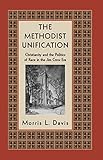The Methodist Unification : Christianity and the Politics of Race in the Jim Crow Era / Morris L. Davis.
Material type: TextSeries: Religion, Race, and Ethnicity ; 20Publisher: New York, NY : New York University Press, [2008]Copyright date: ©2008Description: 1 online resourceContent type:
TextSeries: Religion, Race, and Ethnicity ; 20Publisher: New York, NY : New York University Press, [2008]Copyright date: ©2008Description: 1 online resourceContent type: - 9780814719909
- 9780814785171
- 287/.63 22
- BX8382.A15 D38 2008eb
- online - DeGruyter
| Item type | Current library | Call number | URL | Status | Notes | Barcode | |
|---|---|---|---|---|---|---|---|
 eBook
eBook
|
Biblioteca "Angelicum" Pont. Univ. S.Tommaso d'Aquino Nuvola online | online - DeGruyter (Browse shelf(Opens below)) | Online access | Not for loan (Accesso limitato) | Accesso per gli utenti autorizzati / Access for authorized users | (dgr)9780814785171 |
restricted access online access with authorization star
http://purl.org/coar/access_right/c_16ec
In the early part of the twentieth century, Methodists were seen by many Americans as the most powerful Christian group in the country. Ulysses S. Grant is rumored to have said that during his presidency there were three major political parties in the U.S., if you counted the Methodists.The Methodist Unification focuses on the efforts among the Southern and Northern Methodist churches to create a unified national Methodist church, and how their plan for unification came to institutionalize racism and segregation in unprecedented ways. How did these Methodists conceive of what they had just formed as "united" when members in the church body were racially divided?Moving the history of racial segregation among Christians beyond a simplistic narrative of racism, Morris L. Davis shows that Methodists in the early twentieth century - including high-profile African American clergy - were very much against racial equality, believing that mixing the races would lead to interracial marriages and threaten the social order of American society.The Methodist Unification illuminates the religious culture of Methodism, Methodists' self-identification as the primary carriers of "American Christian Civilization," and their influence on the crystallization of whiteness during the Jim Crow Era as a legal category and cultural symbol.
Mode of access: Internet via World Wide Web.
In English.
Description based on online resource; title from PDF title page (publisher's Web site, viewed 01. Nov 2023)


